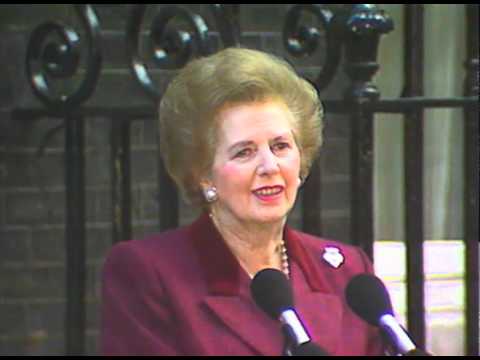Peter Just is a Research Associate at the Centre for Legislative Studies at the University of Hull researching the role of prime ministers after they have resigned. He is the author of ‘Margaret Thatcher: Life After Downing Street’, to be published by Biteback in July.
Margaret Thatcher’s life as a former prime minister has been shrouded in myth, seen through the lens of that iconic photograph of her crying in the back of her car as she left Downing Street for the last time as Prime Minister on 28 November 1990 and Charles Powell’s famous observation that she never had a happy day after ceasing to be Prime Minister.
Yet, as our newly published book – Margaret Thatcher: Life After Downing Street – reveals, there was another side to Lady Thatcher’s life after 1990, one that demands we see her time as an ex-premier in a much more positive light than before and one that requires us to reassess how we view her both as an individual and as an idea.
As an individual after 1990, Margaret Thatcher had a lot of impact and excited a lot of irritation. She generated a lot of noise, but also displayed a lot of nuance. She was the very stuff of showbusiness – with her ‘Margaret Thatchering’ all around the world being something to behold – but she was also the very stuff of substance, largely prophesying the world in which we now live, whether that be developments in the European Union, including the consequences of the single currency, or the importance of American leadership and its engagement with Europe.
At home, she worked in four main areas. First, philosophy, with her being the representation and guardian of her ‘ism’. Second, party, playing a role in various leadership elections, at party conferences, and in general elections – and her relationships with Sir Edward Heath and Sir John Major were a significant feature of her time as a former prime minister. Third, policy, with her concentrating largely on the European Union, the former Yugoslavia, General Pinochet, and Hong Kong and China. Fourth, performance, with her adopting a particular style of being an ex-premier and projecting this back on to her prime ministership and on to perceptions of herself as a prime minister. On occasion, she gave the impression of performing in a production of ‘Carry On Maggie’.
At the same time, she also had a global role. Her lecture tours were one of the ways in which she both earned a living and raised funds for The Margaret Thatcher Foundation. In addition, and not really understood at the time in the United Kingdom, but revealed in files released by The National Archives since her death, she also promoted Britain’s political and commercial interests all around the world after Downing Street – a fact recognised by ministers and officials even while, domestically, she often caused them difficulties.
Early in 1991 one diplomat described her as “a major asset to Britain”, with some years later another official spoke of their being ‘wide acceptance’ in the Foreign Office of “the value to Britain’s foreign policy” of Lady Thatcher’s visits abroad.
But Margaret Thatcher was always more than an individual. She was also an idea, particularly so after Downing Street. This too had global aspects. In the United States of America, she became an icon of Conservatism, with various Republicans seeking her endorsement when making bids to be presidential candidates. This continued after Lady Thatcher’s death too, with Nikki Haley repeatedly referencing her while attempting to win the Republican ticket in 2024.
Elsewhere in the world, politicians were invariably compared to her, almost always unfavourably, or she found herself invoked by them either in relation to their leadership or on particular policies. Again, this also carried on after her death, with Rishi Sunak comparing Italy’s Giorgia Meloni to Lady Thatcher in December 2023.
Back in Britain, Margaret Thatcher’s legacy was essentially three-fold, affecting the Conservative Party, the Labour Party, and herself. Aided and abetted by how Lady Thatcher portrayed herself and her prime ministership after 1990 – and how people reacted and continue to react to her – the idea of Margaret Thatcher has grown ever stronger since she left Downing Street.
Speaking after her death in 2013, Sir John Major spoke of “the Margaret of legend”, describing her “a very big measure to be measured against”. Lady Thatcher’s real legacy as a former prime minister is to have become the measure against which all her successors as party leader and prime minister have been measured – and found wanting (as no doubt Prime Minister Margaret Thatcher would have been on occasion, too).
Often her successors have compared themselves, or have been compared by others, to her – either in relation to her style of leadership or on specific issues. No subsequent Prime Minister has been able to escape the comparisons, often because they have not seemed to want to. Sunak gave the impression of revelling in them when, during the first Conservative leadership election in 2022, he declared: “My values are Thatcherite. I believe in hard work, family and integrity. I am a Thatcherite, I am running as a Thatcherite and I will govern as a Thatcherite.” Of all Lady Thatcher’s successors, Sunak has appeared the most comfortable with her legacy. He repeatedly invoked her during his premiership, including in relation to net zero and inflation.
All this taken together requires us to reframe how we have seen Margaret Thatcher’s life after Downing Street. Yes, for the individual there might have been sadness (but not always the lack of happiness currently widely perceived) – and apparently little tangible difference was made in the policy areas on which she focussed. But, even at the time, there was triumph, both in being Margaret Thatcher and in showing how – with dignity and efficiency – a former prime minister can go on serving their country.
Beyond that, for the idea, there was immortality and invincibility. That is why, even some thirty-five years after she resigned, Margaret Thatcher shines on, and is likely always too; the leader against which all other leaders are, and will be, judged. Indeed, it might not be too much of an exaggeration to say that hers is the premiership on which the sun has never set. It is also why, wherever she ranks as a prime minister, it can truly be said that the United Kingdom has never had a former prime minister like her – and is unlikely ever to have another like her either.
As for the idea that Margaret Thatcher never had a happy day after ceasing to be Prime Minister, well, as our book shows, and as someone close to her commented, that is “complete bullshit”.





![Gavin Newsom Threatens to 'Punch These Sons of B*thces in the Mouth' [WATCH]](https://www.right2024.com/wp-content/uploads/2025/08/Gavin-Newsom-Threatens-to-Punch-These-Sons-of-Bthces-in-350x250.jpg)
![ICE Arrests Illegal Alien Influencer During Her Livestream in Los Angeles: ‘You Bet We Did’ [WATCH]](https://www.right2024.com/wp-content/uploads/2025/08/ICE-Arrests-Illegal-Alien-Influencer-During-Her-Livestream-in-Los-350x250.jpg)








